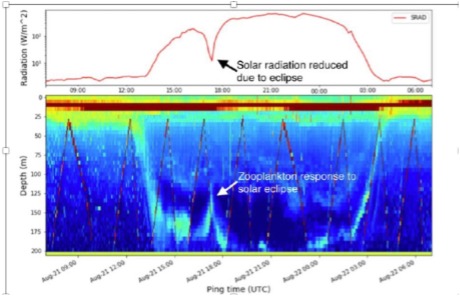Accelerating Marine Ecological Research
Wu-Jung Lee, Applied Physics Laboratory, University of Washington, Seattle, WA, USA. Extracted from OOI Science Plan, 2021.
Mid-trophic level organisms, such as zooplankton and forage fish, play a critical role in mediating energy transfer from primary production to top predators in the marine ecosystem. Many of these animals are also primary targets for fisheries harvest, upon which a significant portion of the society depend. High- frequency active acoustic systems, known as “echosounders,” are the workhorse for observing the distribution and abundance of mid-trophic animals. These instruments work by transmitting sounds into the water column and listening to the echoes bounced off objects. The amplitude and spectral features in the echoes can then be used to infer the type and number of animals in the observed aggregations. As a form of remote sensing, echosounders allow scientists to make continuous observations across large swaths in time and/or space in the ocean, effectively “connect the dots” between discrete locations or times where net trawl samples are collected. The 17 echosounders deployed across OOI’s regional and global arrays (ZPLS Bio- acoustic Sonar [OOI Bio-acoustic Sonar.]) are great examples of this type of observation.
The continuously flowing, openly accessible OOI echosounder datasets provide an excellent opportunity for me to develop new analysis methods and computational tools to efficiently transform active acoustic data to mid-trophic biological information. In an ongoing project funded by the NSF, we are developing novel data-driven methodologies to automatically discover prominent spatio-temporal patterns in the echogram (images formed by echoes, Fig. 2.2 bottom panel), and use these patterns to summarize and describe changes in long-term echosounder time series (Lee et al., 2007). In parallel, we created an open-source software package echopype (Lee et al., 2020) to enable interoperable and scalable processing of echosounder data to extract biological information.
These developments are timely and crucial, because technological advancements in the past decade have resulted in a deluge of echosounder data from a variety of ocean observing platforms, including moorings and autonomous surface and underwater vehicles. The spatial and temporal coverage and the complexity of these data greatly surpass those from ship-based surveys. As a result, the data have overwhelmed the traditional echosounder data processing pipelines. In other words, there is currently a mismatch between instrumentation capacity (to collect large amount of data) and interpretation capability (to analyze these large datasets), and this mismatch is limiting progress in understanding ecosystem response to major environmental disturbance.
My research specifically uses data collected by the network of six upward looking echosounders in the OOI Coastal Endurance Array. These echosounders flank the Columbia River mouth from the north and the south, running roughly in parallel along two cross-shelf moored array lines offshore of Grays Harbor, WA and Newport, OR. Each mooring additionally hosts a large number of sensors for physical, chemical, and lower-trophic biological ocean variables, offering a comprehensive dataset to study causal ecological relationships in this highly dynamic environment within the northern California Current System.
An interesting example of OOI data use is to observe zooplankton’s response to the solar eclipse on August 21, 2017. The diel vertical migration (DVM) of many other marine organisms is a well- known and ubiquitously observed phenomenon in the global ocean that occurs at dawn and dusk (Brierley, 2014). However, during the eclipse as the moon passed in front of the sun and blocks its light, many animals began to migrate up toward the surface, only to swim back down again once the ambient light level returned to normal. This series of events was captured in high resolution by the echosounder deployed on the Endurance Oregon Offshore Cabled Shallow Profiling Mooring (Fig.2.2), due to the fortunate coincidence that this site is located on the path of total eclipse. This example demonstrates the power of persistent ocean observatories, such as the OOI, in delivering multi-faceted and multi-use data for addressing a wide range of scientific questions, as well as in broadening the reach of oceanographic research through open data.
Read more here:
Lee, W. J., & Staneva, V. 2020.Compact representation of temporal processes in echosounder time series via matrix decomposition. Journal of the Acoustical Society of America. DOI: http://doi.org/10.1121/10.0002670.
Todd, R. E., et al. 2019. Global perspectives on observing ocean boundary current systems. Frontiers in Marine Science. DOI: https://doi.org/10.3389/fmars.2019.00423.

